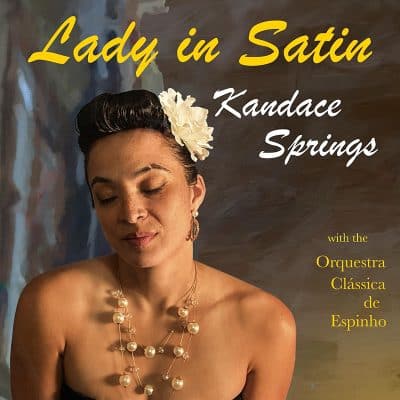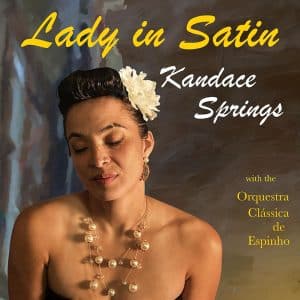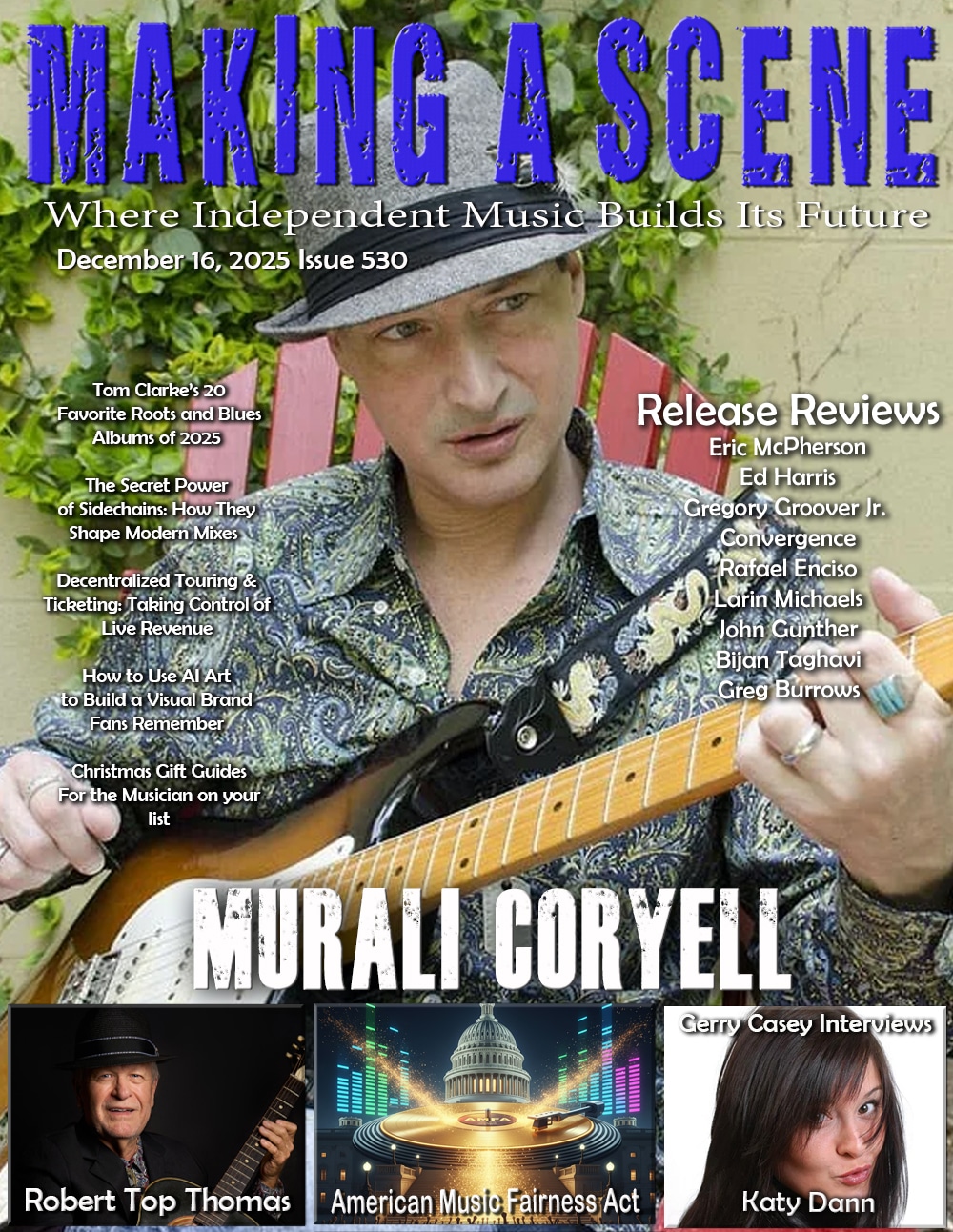Kandace Springs Lady in Satin

Kandace Springs
Lady in Satin
SRP
In her second album on SRP, following her three on Blue Note, Kandace Springs returns with a tribute to Billie Holiday, replicating in her own interpretative way the same tracks that appeared on Holiday’s 1958 iconic Lady in Satin. There are even similarities in the cover art, with Springs displaying Holiday’s signature white gardenia. So, you may be reacting that this is just another jazz vocalist doing Holiday. After all, the list is too exhaustive, but notably it’s been done by Sarah Vaughan, Nina Simone, Esperanza Spalding, Anita Baker, and Cassandra Wilson along with Jose James and the late Andy Bey. What makes this project by Springs stand out, aside from her silky smooth, beautiful voice is the accompaniment of a 60-piece orchestra, Portugal’s Orquestra Classica de Espinho, framing her voice like never before. Yet, this too resembles Holiday who recorded with a 40-piece orchestra with arrangements by Ray Ellis. At the time, although the punch of Holiday’s voice was gone, Ellis described it as earthy and evil despite Holiday’s intention of making a ‘beautiful’ record in the vein of Sinatra or Ella’s Songbook efforts. We can’t possibly ascribe ‘earthy’ and ‘evil’ to Springs’ vocals although she too had every intention of making a ‘beautiful’ record.
Springs did not want to simply imitate Holiday (which would have been disrespectful and rather hard to achieve anyway); she wanted to interpret these songs her own way. To that end, she listened to the tunes fully instrumentally, making notes on how she wanted to approach each of these twelve songs. If you are new to Springs, whose awareness may have slipped some after leaving Blue Note, she is one of the purest singers we have, described perhaps best by her former mentor, Prince, who once said she has “a voice that could melt snow.” If you’ve been fortunate to hear Springs perform live, you’ll come to the same conclusion. I saw her perform at Newport Jazz in 2019 and she absolutely slayed the late Roberta Flack’s signature songs – “Killing Me Softly with His Song” and “The First Time Ever I Saw Your Face,” inducing chills and goosebumps in the process.
This project enabled Springs to realize two of her goals at once – pay tribute to Holiday, and record with an orchestra. A friend connected her with the Orquestra, who surprisingly had been looking to do just such a project. This endeavor took almost a year from end-to-end, as Springs sought out multiple arrangers. They are Nuno Peixoto de Pinho, Carlos Azevedo, Daniel Bernardes, William Goodchild, Pedro Moreira, Telmo Marques. The orchestra, classically oriented, is consistently lush but never dominant, just a pillow-like cushion for Springs’ vocal which remains prominent in the mix throughout a personalized sequence of the dozen songs that differs from the original.
The program commences with Carl Fischer and Bill Carey’s “You’ve Changed,” which, like those that follow, is pretty and soft, lacking the edge of a singer such as Helen Humes, who to these ears has the definitive interpretation on her 1975 The Talk of the Town (Columbia). Following is a simmering version of the oft-covered “You Don’t Know What Love Is,” originally written for the 1941 Abbott and Costello film Keep ‘Em Flying. Springs then delivers Joel S. Harron, Frank Sinatra, and Jack Wolf’s “I’m a Fool to Want You,” Holiday’s self-confessed favorite from her recording. Jimmy Van Heusen and Johnny Burke’s “But Beautiful,” from the 1947 Bing Crosby cinematic vehicle Road to Rio; and Alec Wilder’s “I’ll Be Around,” made a hit in 1943 by the Mills Brothers follow along with Elise Bretton, Sherman Edwards and Don Meyer’s “For Heaven’s Sake, Eileen Tracye Smith’s “The End of a Love Affair” and Rodgers and Hart’s “It’s Easy To Remember,” written for another Bing Crosby film, 1935’s Mississippi.
Despite being hits in their day, Matt Dennis and Tom Adair’s “Violets For Your Furs,” written and first recorded by Frank Sinatra with Tommy Dorsey’s orchestra, and Hoagy Carmichaels “I Get Along Without You Very Well” don’t get covered nearly as often as many of these others, including the closer, Rodgers and Hart’s mainstay “Glad to Be Unhappy.” With regard to “Violets for Your Furs” check out John Coltrane’s version on his 1957 debut, Coltrane (Prestige).
Even with the various arrangers there is a ‘sameness’ to this recording. Surely, it is undeniably gorgeous but lacking the kind of edge and ache we associate with Holiday. In that regard, Springs did it her way (to use a Sinatra phrase).
– JIm Hynes

Buy Us a Cup of Coffee!
Join the movement in supporting Making a Scene, the premier independent resource for both emerging musicians and the dedicated fans who champion them.
We showcase this vibrant community that celebrates the raw talent and creative spirit driving the music industry forward. From insightful articles and in-depth interviews to exclusive content and insider tips, Making a Scene empowers artists to thrive and fans to discover their next favorite sound.
Together, let’s amplify the voices of independent musicians and forge unforgettable connections through the power of music
Make a one-time donation
Make a monthly donation
Make a yearly donation
Buy us a cup of Coffee!
Or enter a custom amount
Your contribution is appreciated.
Your contribution is appreciated.
Your contribution is appreciated.
DonateDonate monthlyDonate yearlyYou can donate directly through Paypal!
Subscribe to Our Newsletter
Order the New Book From Making a Scene
Breaking Chains – Navigating the Decentralized Music Industry
Breaking Chains is a groundbreaking guide for independent musicians ready to take control of their careers in the rapidly evolving world of decentralized music. From blockchain-powered royalties to NFTs, DAOs, and smart contracts, this book breaks down complex Web3 concepts into practical strategies that help artists earn more, connect directly with fans, and retain creative freedom. With real-world examples, platform recommendations, and step-by-step guidance, it empowers musicians to bypass traditional gatekeepers and build sustainable careers on their own terms.
More than just a tech manual, Breaking Chains explores the bigger picture—how decentralization can rebuild the music industry’s middle class, strengthen local economies, and transform fans into stakeholders in an artist’s journey. Whether you’re an emerging musician, a veteran indie artist, or a curious fan of the next music revolution, this book is your roadmap to the future of fair, transparent, and community-driven music.
Get your Limited Edition Signed and Numbered (Only 50 copies Available) Free Shipping Included
Discover more from Making A Scene!
Subscribe to get the latest posts sent to your email.









